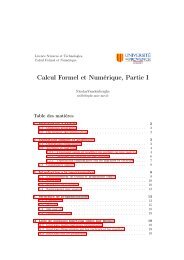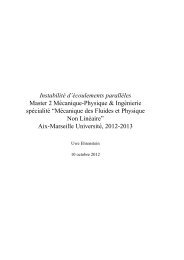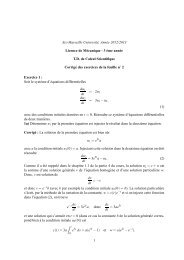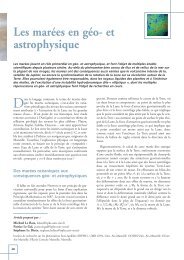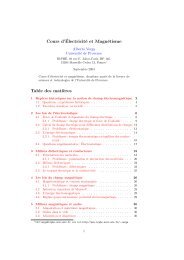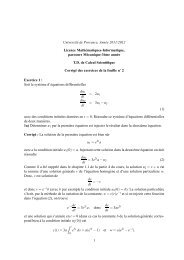Hubert KLAHR
Hubert KLAHR
Hubert KLAHR
Create successful ePaper yourself
Turn your PDF publications into a flip-book with our unique Google optimized e-Paper software.
Les Houches, Feb. 7 th , 2013<br />
Disk Weather: Waves and Instabilities in<br />
Circumstellar Disks<br />
<strong>Hubert</strong> Klahr,<br />
Max-Planck-Institut für Astronomie, Heidelberg<br />
Natalie Raettig, Moritz Beutel, Karsten Dittrich (MPIA), Alex Hubbard(AMNH), Wlad Lyra (JPL),<br />
Peter Bodenheimer (UCSC), Helen Morrison (ITA)<br />
Planetesimal Formation and MHD: Anders Johansen (Lund), Mario FLock (Paris), Rainer Spurzem<br />
12/13/2009 <strong>Hubert</strong> Klahr - Planet Formation - MPIA<br />
1<br />
(NAOC/ARI), Mario Trieloff (HD), Til Birnstiel, Barbara<br />
Heidelberg<br />
Ercolano (USM), Kees Dullemond (ITA),<br />
Chris Ormel (Berkley), Neal Turner (JPL), Doug Lin (KIAA, UCSC)
2 x Weather pattern:<br />
Astrophysical and Geophysical flow<br />
Proto PLANETARY disk<br />
PLANETARY atmosphere
Outline:<br />
The role of<br />
Turbulence in<br />
Planet Formation<br />
• Motivation - Planet Formation<br />
• The rainfall of Planetesimal<br />
precursors and turbulence<br />
• MHD turbulence<br />
• Planetesimal formation via<br />
Gravoturbulence<br />
• Convective Overstability => Vortices<br />
• Goldreich-Schubert-Fricke<br />
• Summary, Conclusions<br />
12/13/2009 <strong>Hubert</strong> Klahr - Planet Formation - MPIA<br />
Heidelberg
“Birth places of Planets:”<br />
Gas and dust disks around young stars<br />
12/13/2009 <strong>Hubert</strong> Klahr - Planet Formation - MPIA<br />
Heidelberg
Planet Formation<br />
time<br />
Surface sticking<br />
Gravoturbulent Planetesimal<br />
Formation from Gravel<br />
concentrated in Vortices and<br />
Zonal Flows<br />
Gravity bound<br />
12/13/2009 <strong>Hubert</strong> Klahr - Planet Formation - MPIA<br />
Heidelberg
particles move inward<br />
= up the pressure gradient<br />
12/13/2009 <strong>Hubert</strong> Klahr - Planet Formation - MPIA<br />
Heidelberg<br />
Pressure maxima:<br />
Klahr & Lin 2000
Laminar disk: No growth beyond 10cm!<br />
Drift time<br />
growth time<br />
12/13/2009 <strong>Hubert</strong> Klahr - Planet Formation - MPIA<br />
Heidelberg<br />
Klahr and Bodenheimer 2006
Particle response in rotating (DISK) frame:<br />
Geostophic flow: balance of pressure and Coriolis forces<br />
H<br />
L<br />
H<br />
VORTICES:<br />
Barge & Sommeria 1995<br />
ZONAL FLOWS:<br />
Radial Pressure maxima<br />
12/13/2009 <strong>Hubert</strong> Klahr - Planet Formation - MPIA<br />
Heidelberg<br />
Whipple 1964; Klahr & Lin 2000
What if there is no global turbulence?<br />
=>Sedimentation to the midplane.<br />
Gravitational instability in the dust midplane<br />
layer?<br />
(Safronov 1969, Goldreich & Ward 1973)<br />
12/13/2009 <strong>Hubert</strong> Klahr - Planet Formation - MPIA<br />
Heidelberg<br />
9
12/13/2009 <strong>Hubert</strong> Klahr - Planet Formation - MPIA<br />
Heidelberg
10 cm sized boulders:<br />
V<br />
e<br />
r<br />
t<br />
i<br />
c<br />
a<br />
l<br />
h o r i z o n t a l<br />
12/13/2009 <strong>Hubert</strong> Klahr - Planet Formation - MPIA<br />
Heidelberg<br />
Johansen, Henning & Klahr 2006
Accretion Energy in rotating systems =><br />
Turbulent transport of angular momentum<br />
alpha = 0.01<br />
Hartmann et al. 1998, 2006<br />
WHY DO T TAURI DISKS ACCRETE?<br />
12/13/2009 <strong>Hubert</strong> Klahr - Planet Formation - MPIA<br />
Heidelberg<br />
12
Turbulence in Disks: Candidates<br />
• Self Gravity until mass too low<br />
• Non-linear Shear Instability<br />
• Magneto-Hydro turbulence<br />
• Rossby-Wave Instability (Kelvin-Helmholtz in<br />
disks) => Heloise Meheut<br />
• Convective Overstability => Vortices<br />
(“subcritical baroclinic instability”)<br />
• Goldreich-Schubert-Fricke<br />
• Critical layer (“Zombie Vortices”) => talk to Phil<br />
Marcus<br />
12/13/2009 <strong>Hubert</strong> Klahr - Planet Formation - MPIA<br />
Heidelberg
Magneto Rotational Instability (MRI)<br />
drives turbulence in accretion disks<br />
12/13/2009 <strong>Hubert</strong> Klahr - Planet Formation - MPIA<br />
14<br />
Simulation by Mario Heidelberg Flock using the Pluto code.
Pluto Code: HLLD<br />
Upwind CT, piecewise<br />
linear reconstruction,<br />
Runge Kutta 2nd order<br />
384x192x768<br />
Flock, Dzyurkevich, Klahr, Turner, Henning, 2011<br />
12/13/2009 <strong>Hubert</strong> Klahr - Planet Formation - MPIA<br />
Heidelberg<br />
Global 360 stratified!<br />
At 20 grid cells per H!<br />
15<br />
1.8 Million CPU hours
…because it is a reliable source for turbulence.<br />
Box:<br />
Disk:<br />
12/13/2009 <strong>Hubert</strong> Klahr - Planet Formation - MPIA<br />
Heidelberg<br />
16
Development of MHD Turbulence<br />
From initial<br />
perturbation to<br />
saturation of the<br />
turbulence<br />
Colors: gas density<br />
yellow = high<br />
blue ! = low<br />
Standard magneto<br />
rotational instability<br />
simulation ala Balbus<br />
12/13/2009 <strong>Hubert</strong> Klahr - Planet Formation - MPIA<br />
Heidelberg<br />
17
Dust Sedimentation<br />
A vertical force<br />
field drives<br />
sedimentation.<br />
Dust number<br />
density:<br />
yellow = high<br />
density<br />
blue = low density<br />
Easy to measure<br />
amplitude<br />
=> diffusivity<br />
12/13/2009 <strong>Hubert</strong> Klahr - Planet Formation - MPIA<br />
Heidelberg<br />
18
2,000,000 boulders of 1m size<br />
12/13/2009 <strong>Hubert</strong> Klahr - Planet Formation - MPIA<br />
Heidelberg<br />
Johansen, Klahr and Henning, 2006<br />
19
1m boulders<br />
=> Gravoturbulent formation of planetesimals:<br />
Johansen, Klahr and Henning, 2006<br />
See Poster by Karsten Dittrich!<br />
12/13/2009 <strong>Hubert</strong> Klahr - Planet Formation - MPIA<br />
Heidelberg
MHD plus self-gravity for the dust, including particle feed back<br />
on the gas: Pencil Code<br />
gas<br />
dust<br />
Poisson equation solved via FFT in parallel mode: up to 256 3 cells<br />
12/13/2009 <strong>Hubert</strong> Klahr - Planet Formation - MPIA<br />
Heidelberg
Formation Of<br />
Planetesimals<br />
From pressure<br />
trapped /<br />
gravitational<br />
Bound heaps of<br />
gravel - here<br />
magnetic<br />
turbulence:<br />
Gravoturbulent formation of<br />
planetesimals - Concentration in<br />
Zonal Flows:<br />
Johansen, Klahr &<br />
Henning 2011.<br />
Vortices: Raettig,<br />
Klahr & Lyra<br />
512 ^2 simulation<br />
64 Mio particles<br />
Entire project<br />
used 15 Mio. CPU<br />
hours.<br />
12/13/2009 <strong>Hubert</strong> Klahr - Planet Formation - MPIA<br />
Heidelberg<br />
22
14 years back...<br />
...before I was doing this<br />
with MHD we tried Thermal<br />
Convection for turbulence<br />
23
My very first vortices:<br />
The historic Simulation:<br />
About 1999<br />
Large Scale<br />
3D – Simulation<br />
90 degree<br />
3.5 – 6.5 AU<br />
102 x 40 x 120 cells<br />
=> Vortices<br />
3D Global Disk Simulation<br />
flux limited Diffusion<br />
temperatur maintained by<br />
artifical (viscous)heating
3D - Radiation Hydro of Convection<br />
in Disks. Klahr, Henning & Kley 1999<br />
12/13/2009 <strong>Hubert</strong> Klahr - Planet Formation - MPIA<br />
Heidelberg<br />
25
Klahr & Bodenheimer 2003<br />
Radial Entropy Gradient leads to vortices<br />
somehow...<br />
Klahr 2004: not a linear instability<br />
Because:<br />
-0.001 > Ri > -0.01<br />
Then a lot of discussion started...<br />
...but 4 years later:<br />
Petersen, Stewart and Julien 2007:<br />
“Works with the right amount<br />
of thermal relaxation!”<br />
12/13/2009 <strong>Hubert</strong> Klahr - Planet Formation - MPIA<br />
Heidelberg<br />
26
Vorticity<br />
Vorticity: Pencil Code: Lyra and<br />
Klahr 2011; β = 2; N = 256; τ c = 1<br />
radial<br />
12/13/2009 <strong>Hubert</strong> Klahr - Planet Formation - MPIA<br />
Heidelberg<br />
27
Lesur and Palaloizou 2010:”Subcritical Baroclinic Instability”<br />
Like Convection Cells:<br />
quasi Boussinesq<br />
φ<br />
r<br />
Convective Overstability!<br />
12/13/2009 <strong>Hubert</strong> Klahr - Planet Formation - MPIA<br />
Heidelberg<br />
28
2D - vertically integrated disk<br />
(Klahr and Hubbard)<br />
Stability under the influence of thermal relaxation<br />
Incompressible Ansatz:<br />
Constant Pressure Structure<br />
12/13/2009 <strong>Hubert</strong> Klahr - Planet Formation - MPIA<br />
Heidelberg<br />
29
2D - vertically integrated disk<br />
(Klahr and Hubbard)<br />
Stability under the influence of thermal relaxation<br />
Linearized and WKB:<br />
=><br />
Rayleigh Criterion<br />
=> Solberg-Hoiland<br />
12/13/2009 <strong>Hubert</strong> Klahr - Planet Formation - MPIA<br />
Heidelberg<br />
30
2D - vertically integrated disk<br />
(Klahr and Hubbard)<br />
Stability under the influence of thermal relaxation<br />
12/13/2009 <strong>Hubert</strong> Klahr - Planet Formation - MPIA<br />
Heidelberg<br />
31
2D - vertically integrated disk<br />
(Klahr and Hubbard)<br />
Stability under the influence of thermal relaxation<br />
2010Similar to Lesur and Papaloizou 2010 for finite size vortices<br />
12/13/2009 <strong>Hubert</strong> Klahr - Planet Formation - MPIA<br />
Heidelberg<br />
32
2D - vertically integrated disk<br />
(Klahr and Hubbard)<br />
Stability under the influence of thermal relaxation<br />
Lesur and Papaloizou 2010: Rayleigh Number!<br />
12/13/2009 <strong>Hubert</strong> Klahr - Planet Formation - MPIA<br />
Heidelberg<br />
33
Vorticity<br />
azimuthal<br />
radial<br />
12/13/2009 <strong>Hubert</strong> Klahr - Planet Formation - MPIA<br />
Heidelberg<br />
34
Density:<br />
zimuthal<br />
12/13/2009 <strong>Hubert</strong> Klahr - Planet Formation - MPIA<br />
Heidelberg<br />
radial<br />
35
Strength of alpha (local)<br />
Raettig, Klahr and Lyra 2013<br />
Growth rates<br />
see also Lesur and Papaloizou 2011<br />
12/13/2009 <strong>Hubert</strong> Klahr - Planet Formation - MPIA<br />
Heidelberg<br />
36
12/13/2009 <strong>Hubert</strong> Klahr - Planet Formation - MPIA<br />
Heidelberg<br />
37
plus accretion rate:<br />
12/13/2009 <strong>Hubert</strong> Klahr - Planet Formation - MPIA<br />
Heidelberg<br />
38
Klahr & Raettig in prep.<br />
Using data from Sean Andrews: Accretion disks in Ophiuchus.<br />
alpha = 0.001; Mdot = 1E-7 Msol/yr;<br />
Plus irradiation: Tstar = 4300; Rstar = 2 Rsol<br />
10 5<br />
10000<br />
[g/cm 2 ]<br />
10 4<br />
10 3<br />
T[K]<br />
1000<br />
100<br />
10 2<br />
0.1 1.0 10.0 100.0<br />
r[AU]<br />
10<br />
0.1 1.0 10.0 100.0<br />
r[AU]<br />
12/13/2009 <strong>Hubert</strong> Klahr - Planet Formation - MPIA<br />
Heidelberg<br />
39
Radial surfacedensity gradient:<br />
+<br />
Radial temperature gradient:<br />
=<br />
Radial pressure gradient:<br />
&<br />
Radial entropy gradient:<br />
As a consequence:<br />
1.: Radially buoyancy:<br />
2.: vertical shear<br />
/thermal wind:<br />
12/13/2009 <strong>Hubert</strong> Klahr - Planet Formation - MPIA<br />
Heidelberg<br />
40
Richardson number &<br />
N 2 =<br />
thermal diffusion time<br />
1 ⇤<br />
H<br />
Ri 2 = N 2<br />
R ⇥ s⇥ p<br />
2<br />
3<br />
2<br />
⇥ 2<br />
⇧ therm = H 2 / D ⌅c v<br />
The saturated state presents a turbulent flow dominated b<br />
Ri<br />
0.001<br />
0.000<br />
0.001<br />
0.002<br />
0.003<br />
MRI<br />
BI<br />
0.004<br />
0.1 1.0 10.0 100.0<br />
r[AU]<br />
therm<br />
100.0<br />
(Mamatsashvili & Chagelishvili 2007 ;Heinemann & Papaloizo<br />
10.0<br />
fluctuation of 10% of the speed of sound and producing<br />
1.0<br />
12/13/2009 <strong>Hubert</strong> Klahr - Planet Formation - MPIA<br />
Heidelberg<br />
0.1<br />
0.1 1.0 10.0 100.0<br />
r[AU]<br />
41<br />
-valu<br />
10 3. Vortices are forming spontaneously out of the creation o<br />
vortices show no sign of decay, yet draw the energy out of the g<br />
providing entropy flux downward the gradient, like in standard
Lyra and Klahr 2011<br />
• BI can be the MIDWIFE for MRI... ;)<br />
12/13/2009 <strong>Hubert</strong> Klahr - Planet Formation - MPIA<br />
Heidelberg<br />
42
Pluto Code: 1024^2; WENO3-RK3; HLLE; FARGO<br />
How to get a critical Vortex?<br />
Here entropy pert. + Klahr 2004!<br />
vortices migrate inward, but are recreated by waves<br />
12/13/2009 <strong>Hubert</strong> Klahr - Planet Formation - MPIA<br />
Heidelberg<br />
from other vortices.<br />
43
vorticity<br />
z<br />
phi<br />
R<br />
12/13/2009 <strong>Hubert</strong> Klahr - Planet Formation - MPIA<br />
Heidelberg<br />
44
2D Local (radial - vertical),<br />
Including thermal wind / vertical<br />
shear! How Come?<br />
12/13/2009<br />
density<strong>Hubert</strong> Klahr - Planet Formation<br />
temperature<br />
- MPIA<br />
45pert.<br />
Heidelberg
2D axissymetric Pluto Simulation: Temperature<br />
due to irradiation from star and thermal<br />
relaxation tau = 0.1 (also works for flux limited<br />
diffusion in irradiated disks)<br />
• eeeeeeee<br />
Star-><br />
Thermal wind:<br />
See Nelson, Gressel &<br />
12/13/2009 <strong>Hubert</strong> Klahr - Planet Formation Umurhan - MPIA astro-ph 46<br />
Heidelberg
2D axissymetric Pluto Simulation:<br />
Overstability due to thermal wind leads to convection like motion:<br />
Symmetric Instability<br />
Modification of Solberg-Hoiland Criterion, including thermal relaxation:<br />
In collaboration with Alexander Hubbard<br />
Or instantanous cooling: Goldreich & Schubert 1967 - Fricke 1968 Instability<br />
12/13/2009 <strong>Hubert</strong> Klahr - Planet Formation - MPIA<br />
Heidelberg<br />
47
2D axissymetric Pluto Simulation:<br />
vertical component of vorticity perturbations<br />
12/13/2009 <strong>Hubert</strong> Klahr - Planet Formation - MPIA<br />
Heidelberg<br />
48
12/13/2009 <strong>Hubert</strong> Klahr - Planet Formation - MPIA<br />
Heidelberg<br />
49
12/13/2009 <strong>Hubert</strong> Klahr - Planet Formation - MPIA<br />
Heidelberg<br />
50
Full 3D Pluto Simulation: Spontanous Formation<br />
of Vortices from tiny perturabtions<br />
=> Baroclinic Disks<br />
Form Vortices<br />
abundantly and<br />
further amplify<br />
them further!<br />
Mission<br />
accomplished.<br />
12/13/2009 <strong>Hubert</strong> Klahr - Planet Formation - MPIA<br />
Heidelberg<br />
51
2D / 3D - Radiation Hydro of<br />
Irrdiated disks in Disks with dust<br />
opacities and realistic parameters!<br />
1•10 14<br />
1•10 14<br />
1•10 14<br />
1•10 14<br />
0.1<br />
1•10 13<br />
1•10 13<br />
0.1<br />
1•10 13<br />
1•10 13<br />
1•10 12<br />
1•10 12<br />
z/r<br />
0.0<br />
z/r<br />
0.0<br />
0.1<br />
1•10 13<br />
0.1<br />
1•10 13<br />
1•10 14<br />
1•10 14<br />
4.5 5.0 5.5<br />
r[AU]<br />
4.5 5.0 5.5<br />
r[AU]<br />
12/13/2009 <strong>Hubert</strong> Klahr - Planet Formation - MPIA<br />
Heidelberg<br />
52
Vertical Buoyancy Frequency:<br />
Including thermal relaxation<br />
For short cooling no internal waves!<br />
Goldreich Schubert Fricke<br />
>><br />
Internal Waves / Crititical Layer<br />
Convective Overstability<br />
12/13/2009 <strong>Hubert</strong> Klahr - Planet Formation - MPIA<br />
Heidelberg<br />
53
12/13/2009 <strong>Hubert</strong> Klahr - Planet Formation - MPIA<br />
Heidelberg<br />
54
Interface<br />
MRI - Dead Zone<br />
Disk Weather<br />
Rossby Wave Inst.<br />
Goldreich-Schubert<br />
-Fricke<br />
See Nelson, Gressel & Umurhan<br />
Convective Overstability<br />
Vortex Amplification<br />
(SBI)<br />
Non-linear Shear<br />
Phil Marcus<br />
Critical Layers<br />
Zombie Vortices<br />
Radial Buoyancy : dS/dr < 0 & dP/dr thermal wind dVphi/dz < 0 Heidelberg 55
Small particles in pressure maxima e.g. a vortex<br />
e.g. Vortex is in balance between Coriolis forces and<br />
pressure = same for Zonal flow. Barge & Sommeria 1995<br />
H<br />
L<br />
12/13/2009 <strong>Hubert</strong> Klahr - Planet Formation - MPIA<br />
Heidelberg
St = 0.05 particles (few millimeter)<br />
(white = x 1000) Natalie Raettig<br />
NEXT STEP:<br />
SELF GRAVITY<br />
12/13/2009 <strong>Hubert</strong> Klahr - Planet Formation - MPIA<br />
Heidelberg<br />
57
Conclusions:<br />
Johansen and Klahr: High resolution simulations of planetesimal formation 7<br />
t=35.0<br />
500<br />
t=35.7<br />
400<br />
• Disk turbulence can be magnetic in nature, but in<br />
resistive regions the thermal structure of the disk<br />
300<br />
creates a thermal wind and eventually vortices.<br />
• Irradiated disks are 200 widely radial buoyant and<br />
thus Vortices are continuously created.<br />
100<br />
• Vortices can concentrate even St = 0.05 dust at<br />
initial abundance of eps = 1E-4 to the streaming<br />
0<br />
200instability 300 400and 500 planetesimal 0 100 formation.<br />
200 300 400 500<br />
t=36.1<br />
500<br />
t=36.2<br />
400<br />
300<br />
12/13/2009 <strong>Hubert</strong> Klahr - Planet Formation - MPIA<br />
200<br />
Heidelberg<br />
58



